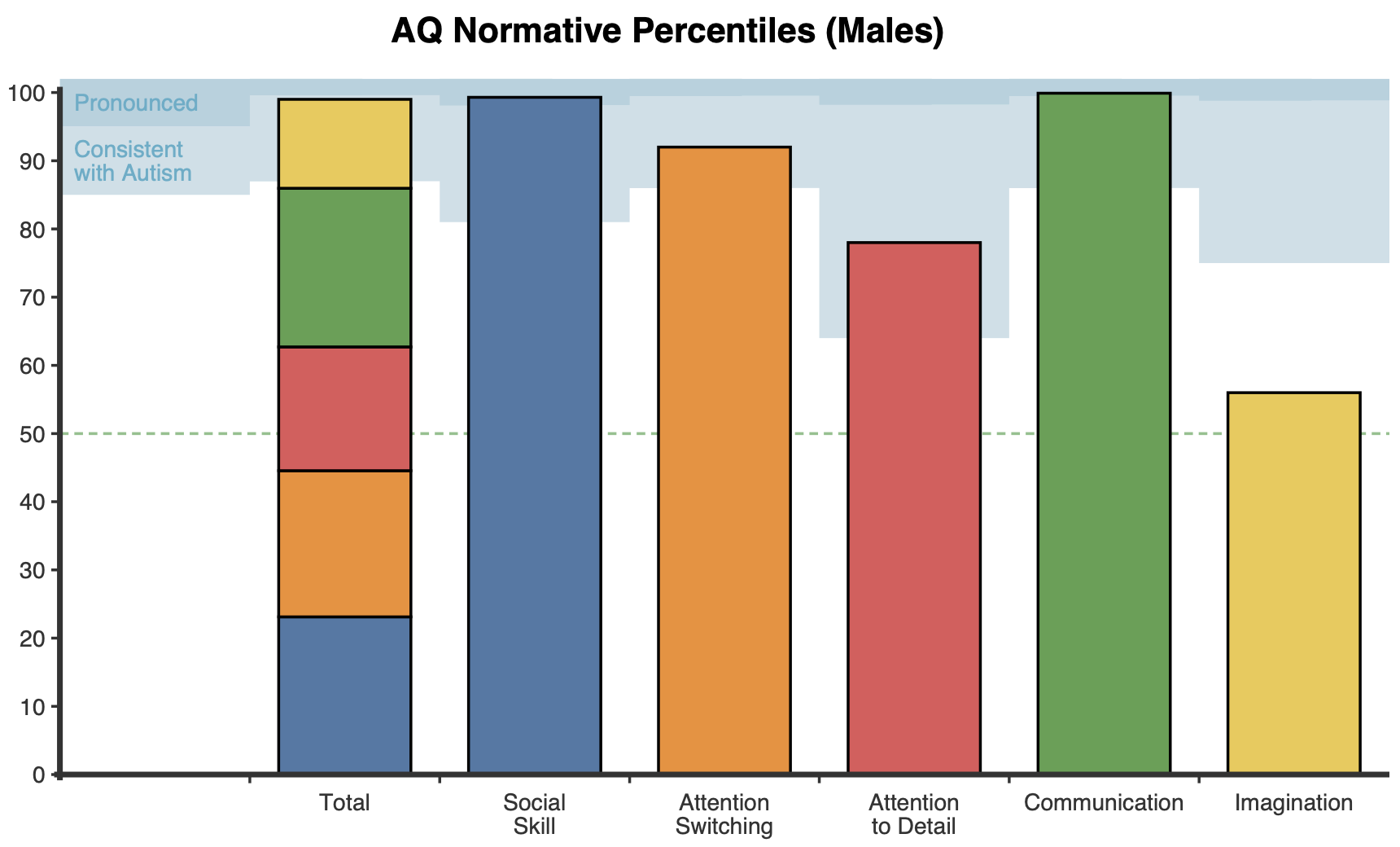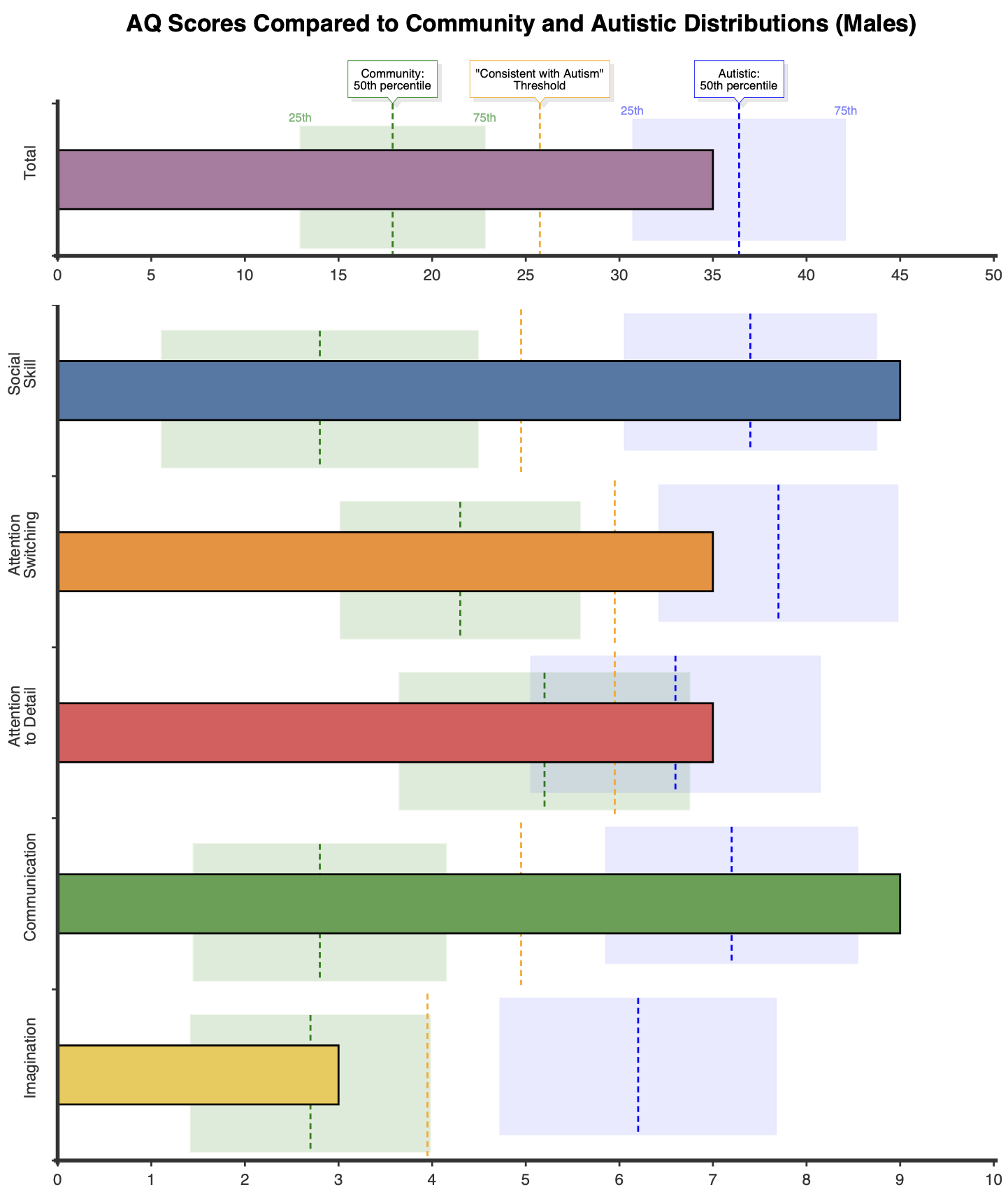The Autism Spectrum Quotient (AQ) is a 50 item self-report measure that assesses autistic traits in adults and people as young as 16 years.
The Autism Spectrum Quotient (AQ) is a 50 item self-report measure that assesses autistic traits in adults and people as young as 16 years (Baron-Cohen et al., 2001). The AQ has five subscales, each representing a specific trait relevant for the identification of Autistic individuals:
The AQ is one of the most widely used self-report measures of autistic traits. Research indicates that it effectively captures autistic-like trait levels and can help differentiate between Autistic and Non-Autistic individuals, even though there is no consensus on the optimal cut-off score (Baron-Cohen et al., 2001; Broadbent et al., 2013; Woodbury-Smith et al., 2005).
While the AQ provides valuable insights into autistic traits and can be used as one part of a comprehensive assessment, scores may also reflect phenomena other than, or co-occurring with, Autism. It is important to interpret the results within the context of the individual’s developmental history and other personal characteristics.
Autism Spectrum Quotient (AQ) scores are presented as a total scale score as well as scores on five subscales. Higher total scale scores are indicative of higher overall levels of autistic traits. A higher subscale score is indicative of a higher level of the specific trait that is associated with Autism.

The client’s total and subscale scores are expressed as (gender-specific) percentiles based on normative data for adults in the general population (Baron-Cohen et al., 2001; Ruzich et al., 2015). The percentiles contextualise the client’s scores relative to the typical scores of adults in the general population. For example, the 50th percentile represents the typical levels of autistic traits among adults in the general population, while scores on the 90th percentile fall within the top 10% when compared to adults in the general population. Scores in this higher range are more consistent with those of Autistic adults than adults in the general population. For the total AQ score, 13% of males and 4% of females score in the range that aligns with the typical scores of Autistic males and females, respectively.

A score is classified as “Consistent with Autism” if it more closely resembles the scores of Autistic adults than those of adults in the general population. To this end, the “Consistent with Autism” thresholds are calculated as the weighted midpoint between the distribution of scores among the Autistic and Nonclinical/Community samples (Jacobson & Truax, 1991).
A score is considered “Pronounced” if it is in the upper half of the Autistic distribution, reflecting higher levels of autistic traits. As such, the “Pronounced” thresholds represent scores on or above the 50th percentile when compared to Autistic adults.
For the Attention to Detail subscale, a higher “Pronounced” threshold reflecting scores on or above the 90th percentile within the Autistic sample was chosen due to significant overlap between the score distributions of the Autistic and Community samples.
Scores classified as either “Consistent with Autism” or “Pronounced” suggest that the client exhibits autistic traits at a level consistent with Autistic adults. Gender-specific distributions of scores, and their classifications, among Autistic adults and adults in the general population are presented in “Autism Spectrum Quotient (AQ): Gender-Specific Norms and Thresholds.”
The thresholds for the total AQ score are as follows.
It is important to note that many measures of Autism, including the AQ, were developed primarily with male characteristics of Autism in mind and may therefore have less sensitivity in measuring Autism in females. Therefore, when a female respondent’s total AQ score is just below the “Consistent with Autism” threshold (e.g., 23-26), it should be interpreted with caution and considered alongside other sources of information as part of a comprehensive assessment.
Graphs comparing the total and subscale scores to the normative distribution of scores among Autistic adults and adults in the general population are presented, with shaded areas corresponding to scores between the 25th and 75th percentile. These graphs contextualise the client’s scores relative to typical levels of autistic traits among Autistic adults and adults in the general population.

The Autism Spectrum Quotient (AQ) comprises 50 items, with 10 items for each of five theoretically derived subscales representing specific trait dimensions associated with autism (Baron-Cohen et al., 2001). Specifically, the items were selected to reflect the “triad” of autistic “symptoms” (i.e., social difficulties, communication issues, and repetitive behaviors) as well as “areas of cognitive abnormality” associated with autism (Baron-Cohen et al., 2001, p. 6).
The AQ was originally validated in Autistic adults (i.e., “adults with Asperger syndrome or high-functioning autism”) and adults drawn from the general population (Baron-Cohen et al., 2001). This initial study found that the AQ’s total scale score is normally distributed and has good test-retest reliability, and that the AQ’s five subscale scores have acceptable internal consistency, with Cronbach’s alpha values between 0.63 and 0.77.
Baron-Cohen and colleagues (2001) suggested that a total scale cut-off score of 32 and above could be used to distinguish between Autistic and Non-Autistic individuals. However, this has been challenged by others such as Woodbury-Smith and colleagues (2005) and Broadbent and colleagues (2013) who reported optimal cut-off scores of 26 and 29, respectively.
In the general population, males typically score higher than females, while Autistic females typically score higher than Autistic males (Baron-Cohen et al., 2001; Broadbent et al., 2013; Ruzich et al., 2015). The consistent differences in AQ scores between males and females highlight the importance of gender-specific norms and cut-off scores. NovoPsych has therefore established gender-specific norms and thresholds, grounded in data from the existing literature, to enhance the interpretability and classification accuracy of AQ scores, as described in “Autism Spectrum Quotient (AQ): Gender-Specific Norms and Thresholds.”
The respondent’s AQ scores are converted to gender-specific percentiles, providing useful information about the degree to which they exhibit autistic traits relative to typical levels among Autistic adults and adults in the general population of the same gender.
Baron-Cohen, S., Wheelwright, S., Skinner, R., Martin, J., & Clubley, E. (2001). The Autism-Spectrum Quotient (AQ): Evidence from Asperger syndrome/high-functioning Autism, males and females, scientists and mathematicians. Journal of Autism and Developmental Disorders, 31(1), 5-17. https://doi.org/10.1023/a:1005653411471
Baron-Cohen, S., Wheelwright, S., Skinner, R., Martin, J., & Clubley, E. (2001). The Autism-Spectrum Quotient (AQ): Evidence from Asperger syndrome/high-functioning Autism, males and females, scientists and mathematicians. Journal of Autism and Developmental Disorders, 31(1), 5-17. https://doi.org/10.1023/a:1005653411471
Broadbent, J., Galic, I., & Stokes, M. A. (2013). Validation of autism spectrum quotient adult version in an Australian sample. Autism Research and Treatment, 2013, 984205. https://doi.org/10.1155/2013/984205
Jacobson, N. S., & Truax, P. (1991). Clinical significance: A statistical approach to defining meaningful change in psychotherapy research. Journal of Consulting and Clinical Psychology, 59(1), 12-19. https://doi.org/10.1037//0022-006x.59.1.12
Ruzich, E., Allison, C., Smith, P., Watson, P., Auyeung, B., Ring, H., & Baron-Cohen, S. (2015). Measuring autistic traits in the general population: A systematic review of the Autism-Spectrum Quotient (AQ) in a nonclinical population sample of 6,900 typical adult males and females. Molecular Autism, 6, 2. https://doi.org/10.1186/2040-2392-6-2
Woodbury-Smith, M. R., Robinson, J., Wheelwright, S., & Baron-Cohen, S. (2005). Screening adults for Asperger Syndrome using the AQ: A preliminary study of its diagnostic validity in clinical practice. Journal of Autism and Developmental Disorders, 35(3), 331-335. https://doi.org/10.1007/s10803-005-3300-7
Article introducing the Autism Spectrum Quotient to NovoPsych, Nov 2020
NovoPsych’s mission is to help mental health services use psychometric science to improve client outcomes.
© 2023 Copyright – NovoPsych – All rights reserved